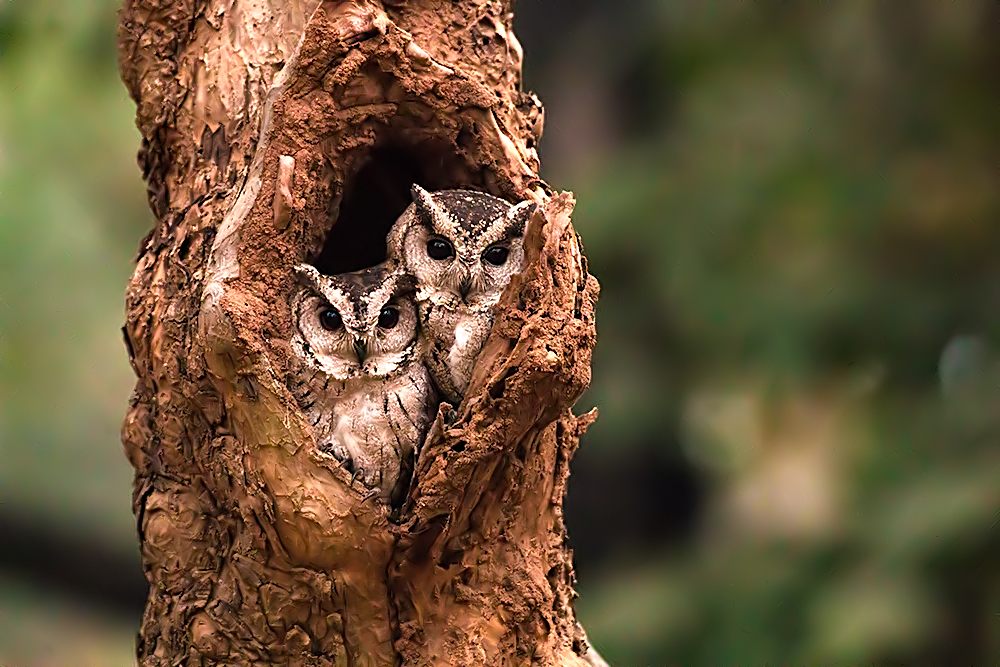IDENTIFICATION: The Collared Scops Owl is a medium-sized (23–25 cm) sandy-brown owl, spotted and mottled dark brown and black, with relatively pointed wings and rather long, dark-spotted ear-tufts. Eyes are dark brown to orange.
SONG: The Song of Collared Scops Owl always contains downward-inflected notes.
Similar species: Sunda, Singapore Scops, Indian, and Japanese Scops Owls are similar in size and coloration but are easily distinguished by their different songs. Sunda Scops, which is darker above and has longer ear-tufts, utters a melodious ‘questioning’, upward-inflected woouk (male) or higher-pitched woik (female); Indian Scops gives more yelping, unmelodious notes with an upward inflection, such as wuatt or what?; Singapore Scops utters a clear ‘kwookh’ at intervals of c.14 seconds, and Japanese Scops utters deep notes with no inflection.
VOCALISATIONS: The song of Collared Scops Owl is a single hoot, repeated at somewhat longer intervals (15–20 seconds) than the quite different notes of Sunda, Singapore, and Indian Scops Owls. Males utter a downward-inflected kwúo and females a slightly higher-pitched and more mewing kwiau, duetting during courtship. When disturbed, both sexes utter a series of chattering notes: wakwakwakwakwak… or uattuattuattuattuatt.
DISTRIBUTION: This owl is found in the E Himalayas, from E Nepal east to Assam, south to E Bengal, Burma, Thailand, Hainan, S China, and Taiwan.
MOVEMENTS: The Collared Scops Owl migrates to South India and the Malay Peninsula in winter.
HABITAT: Forest, scrub, second growth, and also groves of trees and bamboo stands around habitations, open country, and towns. From plains and submontane tracts to c.2400m.
DESCRIPTION: The O. l. lettia adult resembles Sunda and Singapore Scops Owls, but is larger and distinctly paler-coloured above, with long, dark-spotted ear-tufts. Light buffish-brown above, mottled, spotted and freckled with black and buff, and pale grey-buff (grey-brown morph) or more rufousbuff (rufous morph). Scapulars have pale buffish feathers, forming an indistinct stripe on the wing.
There are two pale collars on the hindneck. Underparts are pale brown with small arrowhead-like shaft streaks. Tarsus is fully feathered to the base of toes. Juvenile Mesoptile with narrow, irregular, dark barring overall. The feathering of tarsi usually extends onto toes. Bare parts are dark brown to orange-brown. Bill greenish-horn, paler at tip; lower mandible pale dusky yellow. Toes and claws fleshy-grey to dusky olive; pads yellowish-white.
MEASUREMENTS AND WEIGHT: Total length: 23–25 cm; females are usually larger than males. Wing 158–188mm, tail 75–102mm. Weight 108–170g.
GEOGRAPHICAL VARIATION: We recognize five subspecies. O. l. lettia (Hodgson, 1836). E Himalayas to E Assam, E Bengal, Burma, and Thailand. See Description. We include alboniger and manipurensis as synonyms. Wing 158–180mm, tail 75–91mm. O. (l.) erythrocampe (Swinhoe, 1874). S China. Upperparts brown with buff markings, less greyish than nominate race, with white supercilia, very similar to Japanese Scops Owl. Eyes are more golden-brown to chestnut. Wing 165–180mm, tail 75–94mm. Perhaps specifically distinct according to DNA evidence.
l. glabripes (Swinhoe, 1870). Taiwan. Similar in plumage to Japanese Scops Owl, but has totally bare toes. Wing 178–188mm, tail 94–102mm. O. l. umbratilis (Swinhoe, 1870). Hainan. Compared with glabripes, somewhat paler above and have darker markings. Smaller in size. Wing 161–183mm, tail 84–91mm. O. l. plumipes (Hume, 1870). NW Himalayas from Murree to Naini.
Toes are densely feathered, as in the Japanese Scops Owl, and rather similar in plumage to that species. Differs, however, in vocalizations (song with downwards inflected notes) and in dark brown eyes (red to orange-yellow in Japanese). Wing 173–185mm, tail 80–94mm.
HABITS: Nocturnal, and rarely seen by day. Spends the day lurking in some dark corner on a densely foliaged branch perched upright and motionless, effectively disguised as a branch stump. Its presence is revealed by its distinctive voice; singing continues intermittently throughout the night, in runs of 10–15 minutes duration or longer.
FOOD: The diet of the Collared Scops Owl consists of beetles, grasshoppers, and other insects, but in general, they have a more varied diet than Sunda and Indian Scops Owls, including lizards, mice, and small birds. An individual of the nominated race, shot at 02:30 hours (when singing), had their stomach packed with a freshly ingested mouse.
BREEDING: The Collared Scops Owl breeding season is February–May. Nests in a natural cavity or woodpecker hole in a tree trunk or dead stump, mostly at moderate height (c.2–5 m up). Eggs three or four, rarely five, similar in shape and color to those of related species: 32.3 x 28. The incubation period and other details of breeding biology are unrecorded.
REMARKS: Otus lettia, O. lempiji, O. cnephaeus, O. mentawi, O.fuliginosus, O. semitorques and O. bakkamoena have in the past been lumped together as a single species: Otus bakkamoena. Although they are all very similar in plumage, they are vocally and genetically distinct. The entire group urgently needs revision to determine to which species the various taxa hitherto described should be attributed as subspecies. After considering the morphology and zoogeography of the taxon plumipes we recognize it as a subspecies of O. lettia and not of O. bakkamoena.
STATUS AND CONSERVATION: It is widespread, but local, and generally not uncommon where it occurs.
Read More: Biak Scops Owl

Reference: Owls of the World, by Claus Knig and Friedhelm Weick






